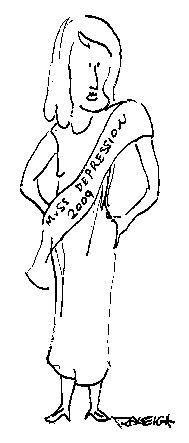 |
Another
Scientific Report
By HENRY P. RALEIGH
ART TIMES December 2008
Certainly
of more interest, I believe, is the Professor’s findings regarding
the type of female movie stars we wish to have comfort us in moments
of financial depression. It turns out, according to the Professor,
that we should be running to film actresses with ‘small eyes, thin
faces, and prominent chins’ and as the Hypothesis reveals, this
is how it was in the 30’s and 40’s. He calls this the ‘mature appearance’
and it was fashionable during the Great Depression and World War
II even if you weren’t a movie star.
Now
it’s not at all clear from the scant data so far available what
actresses the Professor had in mind when he and his friends came
up with the Hypothesis. There is some suspicion that the Professor
may have leaned too heavily on stars like Barbara Stanwyck and Irene
Dunne. Although neither had thin faces or prominent chins you could
say their eyes were smaller than Joan Crawford’s who had enormous
eyes but disappointingly a thin face and a strong, aggressive chin.
Carol Lombard had a slim face, sort of like Greta Garbo’s, as well
as a pretty firm chin; still I wouldn’t call their eyes small. Jean
Harlow and Ann Sothern had large eyes and full faces and how would
the professor feel about Betty Grable or Rita Hayworth? You can
go on like this for all the 30’s and 40’s. Maybe the Environmental
Security Hypothesis should include a couple of those scientific
adages as ‘beauty lies in the eyes of the beholder’ and ‘there is
no accounting for taste’. Actually, the only actress that perfectly
fits the Hypothesis is Margaret Hamilton, best known as the wicked
witch in the 1939 “Wizard of Oz”. If this hatchet-faced lady represented
a mature and comforting figure back in those days it’s no wonder
those were hard times and much worse than has been reported.
Shifting
their scientific attention from faces to bodies, the Professor’s
researchers studied back issues of Playboy magazine and found
this a good deal more exciting. The focus was on changes in the
Playmate of the Year over good and bad times and after much scientific
discussion and whistling spotted a correlation with their studies
of movie stars’ faces. When times were tough the Playmates were
older, had taken on more poundage and were considerably less curvy
than when the Dow was thriving. The Professor didn’t say so, but
I suppose what is good for the Playmate ladies must be true for
the movie star ladies. Still it’s not easy to locate any, past or
present, that can be neatly accommodated by the Professor’s Hypothesis.
Margared Dumont and Marie Dressler might do for the 30’s but that
simply shows you how desperate people were then for any bit of solace.
It’s probably too early in our present economic crisis to see who
will replace our Gwyneth Paltrows and Julia Roberts, but I guess
we should start looking around – not to be an alarmist but
don’t these two already have smallish eyes and are short on curvature?
As
far as I know the Environmental Security Hypothesis hasn’t yet reported
on male movie stars. Maybe once the researchers’ interest in Playmates
of the Year has waned, they’ll tackle that one. It does seem to
me that the Hypothesis suits men better than women stars. Male actors
of the last Depression were generally small-eyed, of resolute chins
and of been-around-the-block maturity – Cagneys, Bogarts,
Mitchums who eventually give way in later boom years to the man/boy
types – the DiCaprios, Cruises, Damons, Afflecks.
Scientifically
speaking I report this here while a Recession rages all about me
but with luck, by the time I finish we may have our very own Great
Depression and can look forward to a completely new team of movies
stars to settle us down. And I’m betting that George Clooney is
the harbinger of the new Depression male. And I for one am glad
of it.
